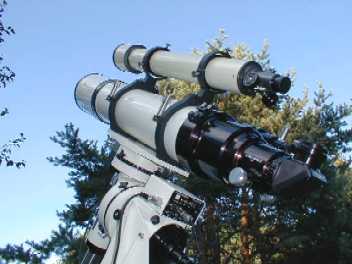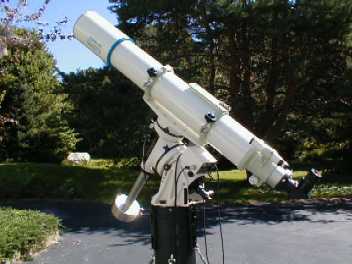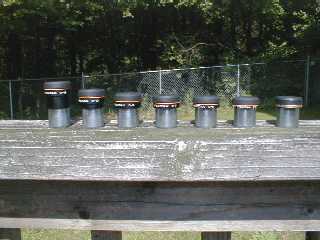Clash of the Titans:
Ultimate Refractor Comparo
The AP155 Takes on the Takahashi FS152
by Ed Ting
Updated 9/18/00
 Expensive Glass: The AP155 (top)
and the FS152 (bottom)
Dateline August 20, 2000, 1:30 AM. It was a dark and stormy night. Five
intrepid astronomers spent the earlier part evening setting up the AP155
and the FS152 refractors in my driveway. We all went home to catch quick
naps, agreeing to meet back at the scopes at 2:15 AM. But it was now
approaching 1:30 AM, and there were bad signs ahead.
The danger signs were on the horizon. It was GOING to be a dark and stormy
night, and soon. The clear skies of a few hours before were threatening to
open up into a torrential downpour. I could hear the rumbling in the distance,
growing closer. Would I be stuck disassembling the scopes myself in the
dark, and in the rain?
I had to get downstairs and into the driveway, and fast. But the closer the rumbling
got, the less I was able to move. It was as if my shoes were filled with lead. The
rumbling got louder and louder, until...
...Until the alarm went off. Groggy, I reached over and hit the snooze button. Isn't
it funny what we dream about when we're planning to get up in the middle of the night
to go observing?
The "rumbling" in my dream was the oil furnace in the house, which was unusually
active during this incredible summer of 2000, the coolest in memory. Outside
the temperature hovered around 45 degrees. It felt more like October than August.
I slipped on my leather jacket and wandered outside to the clearest, steadiest
skies I'd seen in quite some time.
As it turned out, I was one of the last to arrive at my own star party. Dave,
Mike, and Chase were already tinkering with the equipment. In the east, Saturn,
Jupiter, and Aldeberan burned brightly in the sky, forming a temporary seasonal
triangle.
Ever since I'd had the Takahashi FS152 (on generous loan from Todd Gross) I
had been wondering how it would fare against the AP155. Conventional wisdom
states that the Tak will have the edge on contrast (due to the simpler design
and the knife-edge baffles), but the AP would have better color correction due
to the triplet objective. Would our prejudices hold up? Or would observation
throw us a curve ball? We were anxious to find out.
Also present were a TeleVue 102 and a Genesis. In the garage, I had my
Traveler, the 10" Starmaster EL, the 20" Obsession, and there was an AP
Star12 waiting in the wings.
The Astro-Physics 155 (6" f/7 triplet apochromat, $5400) has long been the
standard-bearer in its class. This one was mounted on AP's superb AP900
mount, complete with a Goto system and AP's 80 mm guidescope. The rig
looks lean and mean, and drew a gasp from the group when set up earlier
in the evening. If you want one, get in line - AP's legendary waiting list
suggests you might see one in three or four years if you get on the list today.
Expensive Glass: The AP155 (top)
and the FS152 (bottom)
Dateline August 20, 2000, 1:30 AM. It was a dark and stormy night. Five
intrepid astronomers spent the earlier part evening setting up the AP155
and the FS152 refractors in my driveway. We all went home to catch quick
naps, agreeing to meet back at the scopes at 2:15 AM. But it was now
approaching 1:30 AM, and there were bad signs ahead.
The danger signs were on the horizon. It was GOING to be a dark and stormy
night, and soon. The clear skies of a few hours before were threatening to
open up into a torrential downpour. I could hear the rumbling in the distance,
growing closer. Would I be stuck disassembling the scopes myself in the
dark, and in the rain?
I had to get downstairs and into the driveway, and fast. But the closer the rumbling
got, the less I was able to move. It was as if my shoes were filled with lead. The
rumbling got louder and louder, until...
...Until the alarm went off. Groggy, I reached over and hit the snooze button. Isn't
it funny what we dream about when we're planning to get up in the middle of the night
to go observing?
The "rumbling" in my dream was the oil furnace in the house, which was unusually
active during this incredible summer of 2000, the coolest in memory. Outside
the temperature hovered around 45 degrees. It felt more like October than August.
I slipped on my leather jacket and wandered outside to the clearest, steadiest
skies I'd seen in quite some time.
As it turned out, I was one of the last to arrive at my own star party. Dave,
Mike, and Chase were already tinkering with the equipment. In the east, Saturn,
Jupiter, and Aldeberan burned brightly in the sky, forming a temporary seasonal
triangle.
Ever since I'd had the Takahashi FS152 (on generous loan from Todd Gross) I
had been wondering how it would fare against the AP155. Conventional wisdom
states that the Tak will have the edge on contrast (due to the simpler design
and the knife-edge baffles), but the AP would have better color correction due
to the triplet objective. Would our prejudices hold up? Or would observation
throw us a curve ball? We were anxious to find out.
Also present were a TeleVue 102 and a Genesis. In the garage, I had my
Traveler, the 10" Starmaster EL, the 20" Obsession, and there was an AP
Star12 waiting in the wings.
The Astro-Physics 155 (6" f/7 triplet apochromat, $5400) has long been the
standard-bearer in its class. This one was mounted on AP's superb AP900
mount, complete with a Goto system and AP's 80 mm guidescope. The rig
looks lean and mean, and drew a gasp from the group when set up earlier
in the evening. If you want one, get in line - AP's legendary waiting list
suggests you might see one in three or four years if you get on the list today.
 A beauty of a setup. The
AP155 on the AP900 mount
By the way, the quality of AP's products is such that even little throwaway
items like that guidescope ($425) turn out to be big surprises. I have split
Delta Cygnus and Epsilon Bootes with it, and its views of Saturn were quite
stunning for such a small achromat. During the course of the evening, I found
myself remarkably content to look through that guidescope while waiting for
my turn to look through the AP155.
On the other hand there's the FS152 (6" f/8 doublet fluorite apochromat),
the flagship model in a proud line of world-class refractors. It's expensive
at nearly $10K for the OTA alone, but unlike the AP, you can actually get
one within a reasonable length of time if you want one. The FS152 is
often mentioned as a Dream Scope by many people who have spent happy
hours in the company of an FC76 or an FS102.
A beauty of a setup. The
AP155 on the AP900 mount
By the way, the quality of AP's products is such that even little throwaway
items like that guidescope ($425) turn out to be big surprises. I have split
Delta Cygnus and Epsilon Bootes with it, and its views of Saturn were quite
stunning for such a small achromat. During the course of the evening, I found
myself remarkably content to look through that guidescope while waiting for
my turn to look through the AP155.
On the other hand there's the FS152 (6" f/8 doublet fluorite apochromat),
the flagship model in a proud line of world-class refractors. It's expensive
at nearly $10K for the OTA alone, but unlike the AP, you can actually get
one within a reasonable length of time if you want one. The FS152 is
often mentioned as a Dream Scope by many people who have spent happy
hours in the company of an FC76 or an FS102.
 Another Beauty: The FS152
Don't ask us which one looks better; the votes in the looks category were
split. Suffice it to say, if you own either one, you WILL get a lot of attention
at star parties. Both scopes are large, but the AP155 is surprisingly com-
pact for a 6" refractor. The Takahashi is much longer at about 52 inches
and requires a taller mount as a result. But since the AP has a triplet as
its objective, the scopes wind up weighing about the same, at around 24-27
lbs.
So here we were, gathered at 2 AM to look at Jupiter and Saturn. This was
going to be a test of strength against strength. Would one side yield?
Would it be possible to determine a winner amongst such exalted engineering
statements?
The AP155 spent the morning aboard the fabulous AP900 mount (about $7,000+
with accessories attached) while the FS152 was rigged onto Meade's LXD750.
Both setups were solid and steady and caused no problems. Between the
five of us, we own nearly every premium eyepeice made today, so it was not
difficult to match powers (later the next morning while cleaning up, my garage
looked like an explosion in a lens cap factory. I also hope that all those 7 mm
and 9 mm Naglers wound up going home with the correct owners.)
We started out with TeleVue Plossls, Naglers, Panoptics, and Radians, but
eventually switched to the Pentax orthos (unfortunately NLA) which are
inconvenient but are perhaps the sharpest eyepieces I have ever seen.
Both telescopes are reference-quality refractors that deliver super-sharp,
contrasty images. They are so good that observing run-of-the-mill deep
sky objects like the Ring or Dumbbell at low power is not enough to tell
them apart. You need to observe tight doubles and planets at high power
to see any real differences.
Everyone was anxious to get going, so we immediately trained the scopes on
Saturn for the first comparison. At 121X to 203X, the FS152 was stunning.
Cassini's division was seen all the way around the planet with direct vision.
The planet and rings were razor sharp and looked etched into the inky black
background. But...the AP155 looked ever so slightly sharper. The disc was
slightly whiter as well (the planet was very slightly "yellow" looking through
the FS152.)
The atmosphere was holding up well around 200X so we used the short focal
length Pentax orthos in both scopes (Dave owns two complete sets, so there
were plenty to go around.) On Jupiter, there were nearly a dozen belts visible
in times of good seeing. Both scopes showed impressive detail, but again,
the edge was given to the AP, which was consistently better, more of the
time. True to its nature, the Tak exhibited slightly better contrast in the
razor-thin edge between planet and background. I should point out that only
three out of five of us saw this contrast differential, and those who did see
it ranked it as very minimal.
Another Beauty: The FS152
Don't ask us which one looks better; the votes in the looks category were
split. Suffice it to say, if you own either one, you WILL get a lot of attention
at star parties. Both scopes are large, but the AP155 is surprisingly com-
pact for a 6" refractor. The Takahashi is much longer at about 52 inches
and requires a taller mount as a result. But since the AP has a triplet as
its objective, the scopes wind up weighing about the same, at around 24-27
lbs.
So here we were, gathered at 2 AM to look at Jupiter and Saturn. This was
going to be a test of strength against strength. Would one side yield?
Would it be possible to determine a winner amongst such exalted engineering
statements?
The AP155 spent the morning aboard the fabulous AP900 mount (about $7,000+
with accessories attached) while the FS152 was rigged onto Meade's LXD750.
Both setups were solid and steady and caused no problems. Between the
five of us, we own nearly every premium eyepeice made today, so it was not
difficult to match powers (later the next morning while cleaning up, my garage
looked like an explosion in a lens cap factory. I also hope that all those 7 mm
and 9 mm Naglers wound up going home with the correct owners.)
We started out with TeleVue Plossls, Naglers, Panoptics, and Radians, but
eventually switched to the Pentax orthos (unfortunately NLA) which are
inconvenient but are perhaps the sharpest eyepieces I have ever seen.
Both telescopes are reference-quality refractors that deliver super-sharp,
contrasty images. They are so good that observing run-of-the-mill deep
sky objects like the Ring or Dumbbell at low power is not enough to tell
them apart. You need to observe tight doubles and planets at high power
to see any real differences.
Everyone was anxious to get going, so we immediately trained the scopes on
Saturn for the first comparison. At 121X to 203X, the FS152 was stunning.
Cassini's division was seen all the way around the planet with direct vision.
The planet and rings were razor sharp and looked etched into the inky black
background. But...the AP155 looked ever so slightly sharper. The disc was
slightly whiter as well (the planet was very slightly "yellow" looking through
the FS152.)
The atmosphere was holding up well around 200X so we used the short focal
length Pentax orthos in both scopes (Dave owns two complete sets, so there
were plenty to go around.) On Jupiter, there were nearly a dozen belts visible
in times of good seeing. Both scopes showed impressive detail, but again,
the edge was given to the AP, which was consistently better, more of the
time. True to its nature, the Tak exhibited slightly better contrast in the
razor-thin edge between planet and background. I should point out that only
three out of five of us saw this contrast differential, and those who did see
it ranked it as very minimal.
 Baby Jake (owned by Mike T) stands
guard over the Astro-Physics cases
The 3rd quarter moon was up, and we caught scores of craterlets in Plato
(the seeing was good enough that two craterlets were seen even in the 80
mm guidescope on the AP.) Again, the AP155 seemed slightly sharper, and
formed a "whiter" image as well, with no color on the limb. Going directly
from the AP to the FS152, I found I could "train" myself to see a tiny trace
of color on the limb of the moon. It was subtle, but there nonetheless.
And so it went throughout the morning. Every time I thought the image in
the FS152 couldn't possibly be beat, I would wander over to the AP155 and
the image would be just as good, and sometimes even a tad better. This
is NOT to suggest the Takahashi isn't a telescope of a lifetime. It is.
Any one of us would be thrilled to own it. Both refractors walked all over
the TV102 and the Genesis. But the AP outdid the Tak in every category we
came up with, with the possible exception of contrast around bright objects.
We star tested both telescopes on Capella. At 150X, the Astro-Physics
was showing near-perfect correction, with no false color at all. The
Takahashi gave us a little more to talk about. The optics are under-
corrected a bit, and you can see a minor purple halo if you know where to
look. Pushing to 200X, the AP starts showing a tad of overcorrection,
while the Tak's diffraction images start degrading. We ran one test at
stupid-high power - the FS152 was pushed to 900X. While there was a lot
of false color at this magnification, the airy disk was still circular and
the image was clean, indicating superb lens alignment and collimation
(this also ended any speculation that the FS152 wasn't collimated.)
Baby Jake (owned by Mike T) stands
guard over the Astro-Physics cases
The 3rd quarter moon was up, and we caught scores of craterlets in Plato
(the seeing was good enough that two craterlets were seen even in the 80
mm guidescope on the AP.) Again, the AP155 seemed slightly sharper, and
formed a "whiter" image as well, with no color on the limb. Going directly
from the AP to the FS152, I found I could "train" myself to see a tiny trace
of color on the limb of the moon. It was subtle, but there nonetheless.
And so it went throughout the morning. Every time I thought the image in
the FS152 couldn't possibly be beat, I would wander over to the AP155 and
the image would be just as good, and sometimes even a tad better. This
is NOT to suggest the Takahashi isn't a telescope of a lifetime. It is.
Any one of us would be thrilled to own it. Both refractors walked all over
the TV102 and the Genesis. But the AP outdid the Tak in every category we
came up with, with the possible exception of contrast around bright objects.
We star tested both telescopes on Capella. At 150X, the Astro-Physics
was showing near-perfect correction, with no false color at all. The
Takahashi gave us a little more to talk about. The optics are under-
corrected a bit, and you can see a minor purple halo if you know where to
look. Pushing to 200X, the AP starts showing a tad of overcorrection,
while the Tak's diffraction images start degrading. We ran one test at
stupid-high power - the FS152 was pushed to 900X. While there was a lot
of false color at this magnification, the airy disk was still circular and
the image was clean, indicating superb lens alignment and collimation
(this also ended any speculation that the FS152 wasn't collimated.)
 The Pentax XL Orthos - Incredibly sharp,
but discontinued
In a big surprise, the Takahashi's focuser garnered almost universal
condemnation. Takahashi's focusers are generally known to be the best
in the business. This one seemed unusually stiff. I opened up the
focuser to find that this 4" version is a different design than the 2" units
on their smaller telescopes. Even after tweaking, I couldn't get the
buttery-smooth feel that I am accustomed to. On the other hand, the
AP's mechanics drew nothing but praise.
Dawn came much too quickly for us, and the last thing we did was look at
the Trapezium in the pre-dawn light. One by one, the group dissipated
into the brightening morning. I struggled inside and back to bed for a few
hours, to dream about telescopes and observing. The "dark and stormy
night" had turned out to be productive after all.
The Pentax XL Orthos - Incredibly sharp,
but discontinued
In a big surprise, the Takahashi's focuser garnered almost universal
condemnation. Takahashi's focusers are generally known to be the best
in the business. This one seemed unusually stiff. I opened up the
focuser to find that this 4" version is a different design than the 2" units
on their smaller telescopes. Even after tweaking, I couldn't get the
buttery-smooth feel that I am accustomed to. On the other hand, the
AP's mechanics drew nothing but praise.
Dawn came much too quickly for us, and the last thing we did was look at
the Trapezium in the pre-dawn light. One by one, the group dissipated
into the brightening morning. I struggled inside and back to bed for a few
hours, to dream about telescopes and observing. The "dark and stormy
night" had turned out to be productive after all.
The Verdict: The Observers Speak
What follows is a distillation of the comments I received, both verbally and
in e-mail, in the days following this test. You will recognize some of these
names from the Three Way Super Comparo. All are experienced observers
and bona-fide equipment geeks (we've owned over 100 telescopes between us.)
Chase M: The AP has the edge on sharpness. The combination of the scope
and mount is world class and I hope I will have something like that in the
future. I had troubles with the Tak focuser all night long. Verdict: AP155
John P: This was a great reason to get up in the middle of the night. The
AP was better. But I think the Zambuto-equipped Starmaster 7" Oak Classic
and 10" EL are at least as good, and they cost less. I'd buy a Starmaster.
Between the refractors, if money were no object, I'd still buy the Astro-
Physics. Verdict: AP155
Dave S: It was easier to see Cassini's more of the time through the AP.
But the Tak is very close. I didn't see the contrast difference these guys
were talking about. Verdict: AP155
Mike T: There was color and spherical aberration in the FS152. The FS102
and FC76 I have are close to perfect, why isn't this one? I didn't see any
contrast differences. I expected more from the Tak. Verdict: AP155
Ed T: As regular readers are aware, I am a big fan of both marques. These
telescopes are both superb, and it seems a little decadent and churlish to
have to pick one. But the AP edges out the Tak on image sharpness and
color correction, and it's the one I'd buy if I could. Verdict: AP155
Conclusion: Well, well...Look what we have here. A unanimous decision.
While the AP155 won all of the first place votes, most of us are quick to point
out that the FS152 still gave wonderful views and was never far behind. We
just wished for a little more finesse in the figure of the lens, the focuser, and
the color correction.
There is one factor in favor of the Takahashi, however: You can get one.
Waiting lists on AP refractors are legendary these days, and I can think of
far worse fates than spending three or four years in the company of an
FS152 while waiting for your AP155 to come in.
So this Clash of the Titans ended with a clear victor. Well done, Astro-Physics!
-Ed
End Ultimate Refractor Comparo
Back to Home Page
 Expensive Glass: The AP155 (top)
and the FS152 (bottom)
Expensive Glass: The AP155 (top)
and the FS152 (bottom) A beauty of a setup. The
AP155 on the AP900 mount
A beauty of a setup. The
AP155 on the AP900 mount Another Beauty: The FS152
Another Beauty: The FS152 Baby Jake (owned by Mike T) stands
guard over the Astro-Physics cases
Baby Jake (owned by Mike T) stands
guard over the Astro-Physics cases The Pentax XL Orthos - Incredibly sharp,
but discontinued
The Pentax XL Orthos - Incredibly sharp,
but discontinued